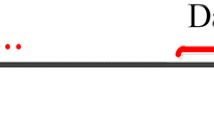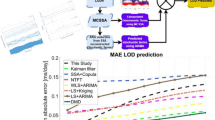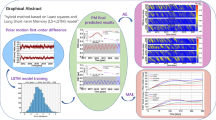Abstract
As one of the main components of the Earth orientation parameters, short-term prediction of the geodetic polar motion series is crucial in the field of deep-space exploration, high-precision positioning, and timing services, which require high real-time performance. Additionally, its middle- and long-term prediction is equally important in climate forecasting and geodynamics research. In this study, we propose the combined BiLSTM+ARIMA model, which is based on bidirectional long- and short-term memory (BiLSTM) and autoregression integrated moving average (ARIMA). First, ensemble empirical mode decomposition (EEMD) is performed as a filter to decompose the polar motion time series to obtain low- and high-frequency signals. The EOP14 C04 time series provided by International Earth Rotation and Reference Systems Service and decomposed by EEMD includes low-frequency signals like the long-term trend, decadal oscillation, Chandler wobble, and prograde annual wobble, along with shorter-period high-frequency signals. Second, low- and high-frequency signals are predicted using BiLSTM and ARIMA models, respectively. Finally, the low- and high-frequency signal forecast components are reconstructed to obtain geodetic polar motion predictions. In middle- and long-term polar motion prediction, the results show that the proposed model can improve the prediction accuracy by up to 42% and 17%, respectively. This demonstrated that the BiLSTM+ARIMA model can effectively improve the accuracy of polar motion prediction.
Similar content being viewed by others
Explore related subjects
Discover the latest articles and news from researchers in related subjects, suggested using machine learning.References
Abduljabbar R.L., Dia H. and Tsai P.-W., 2021. Development and evaluation of bidirectional LSTM freeway traffic forecasting models using simulation data. Sci. Rep., 11, Art.No. 23899, https://doi.org/10.1038/s41598-021-03282-z
Akyilmaz O. and Kutterer H., 2004. Prediction of Earth rotation parameters by fuzzy inference systems. J. Geodesy, 78, 82–93, https://doi.org/10.1007/s00190-004-0374-5
Akyilmaz O., Kutterer H., Shum C.K. and Ayan T., 2011. Fuzzy-wavelet based prediction of Earth rotation parameters. Appl. Soft. Comput., 11, 837–841, https://doi.org/10.1016/j.asoc.2010.01.003
Al-Hnaity B. and Abbod M., 2015. A novel hybrid ensemble model to predict FTSE100 index by combining neural network and EEMD. 2015 European Control Conference (ECC), Linz, Austria, 3021–3028, https://doi.org/10.1109/ECC.2015.7330997
Bizouard C., Lambert S., Gattano C., Becker O. and Richard J.-Y., 2019. The IERS EOP 14C04 solution for Earth orientation parameters consistent with ITRF 2014. J. Geodesy, 93, 621–633, https://doi.org/10.1007/s00190-018-1186-3
Dill R., Dobslaw H. and Thomas M., 2019. Improved 90-day Earth orientation predictions from angular momentum forecasts of atmosphere, ocean, and terrestrial hydrosphere. J. Geodesy, 93, 287–295, https://doi.org/10.1007/s00190-018-1158-7
Gross R., 2015. Earth rotation variations - long period. In: Schubert G. (Ed.), Treatise on Geophysics. Volume 3, Second Edition, 215–261, Elsevier, Amsterdam, The Netherlands, https://doi.org/10.1016/B978-0-444-53802-4.00059-2
Gross R., 2000. The excitation of the Chandler wobble. Geophys. Res. Lett., 27, 2329–2332, https://doi.org/10.1029/2000GL011450
Guo J.Y. and Han Y.B., 2009. Seasonal and inter-annual variations of length of day and polar motion observed by SLR in 1993–2006. Chin. Sci. Bull., 54, 46–52, https://doi.org/10.1007/s11434-008-0504-1
Guo J.Y., Li Y.B., Dai C.L. and Shum C.K., 2013. A technique to improve the accuracy of Earth orientation prediction algorithms based on least squares extrapolation. J. Geodyn., 70, 36–18, https://doi.org/10.1016/jjog.2013.06.002
Guo W. and Zuo J.M., 2017. Adaptive signal decomposition methods for vibration signals of rotating machinery. in: Demetgul M. and Ünal M. (Eds), Fault Diagnosis and Detection. IntechOpen, Rijeka, Croatia, https://doi.org/10.5772/67530
Hu P., Tong J., Wang J., Yang Y. and Oliveira Turci L., 2019. A hybrid model based on CNN and Bi-LSTM for urban water demand prediction. IEEE Congress on Evolutionary Computation (CEC), Wellington, New Zealand, 1088–1094, https://doi.org/10.1109/CEC.2019.8790060
Jia S., Xu T., Sun Z. and Li J., 2017. Middle and long-term prediction of UT1-UTC based on combination of Gray model and autoregressive integrated moving average. Adv. Space Res., 59, 888–894, https://doi.org/10.1016/j.asr.2016.05.044
Kalarus M., Schuh H., Kosek W., Akyilmaz O., Bizouard C., Gambis D., Gross R., Jovanovic B., Kumakshev S., Kutterer H., Cerveira P.J.M., Pasynok S. and Zotov L., 2010 Achievements of the Earth orientation parameters prediction comparison campaign. J. Geodesy, 84, 587–596, https://doi.org/10.1007/s00190-010-0387-1
King M.A. and Watson C.S., 2014. Geodetic vertical velocities affected by recent rapid changes in polar motion. Geophys. J. Int., 199, 1161–1165, https://doi.org/10.1093/gji/ggu325
Kosek W., 2012. Future improvements in EOP prediction. In: Kenyon S., Pacino M.C. and Marti U. (Eds), Geodesy for Planet Earth. International Association of Geodesy Symposia, 136, Springer, Berlin, Heidelberg, Germany, 513–520, https://doi.org/10.1007/978-3-642-20338-1_62
Kosek W., McCarthy D.D. and Luzum B.J., 1998. Possible improvement of Earth orientation forecast using autocovariance prediction procedures. J. Geodesy, 72, 189–199, https://doi.org/10.1007/s001900050160
Liao D.C., Wang Q.J., Zhou Y.H., Liao X.H. and Huang C.L., 2012. Long-term prediction of the Earth Orientation Parameters by the artificial neural network technique. J. Geodyn., 62, 87–92, https://doi.org/10.1016/j.jog.2011.12.004
Lin C.S., Chiu S.H. and Yu L., 2012. Empirical mode decomposition-based least squares support vector regression for foreign exchange rate forecasting. Econ. Model., 29, 2583–2590, https://doi.org/10.1016/j.econmod.2012.07.018
Liu G. and Guo J., 2019. Bidirectional LSTM with attention mechanism and convolutional layer for text classification. Neurocomputing, 337, 325–338, https://doi.org/10.1016/j.neucom.2019.01.078
Liu X., Zhang Y. and Zhang Q., 2022. Comparison of EEMD-ARIMA, EEMD-BP and EEMD-SVM algorithms for predicting the hourly urban water consumption. J. Hydroinf., 24, 535–558, https://doi.org/10.2166/hydro.2022.146
McCarthy D.D. and Seidelmann P.K., 2018. Time: From Earth Rotation to Atomic Physics. Cambridge University Press, Cambridge, U.K.
Modiri S., Belda S., Hoseini M., Heinkelmann R., Ferrándiz J.M. and Schuh H., 2020. A new hybrid method to improve the ultra-short-term prediction of LOD. J. Geodesy, 94, Art.No. 23, https://doi.org/10.1007/s00190-020-01354-y
Noll C.E., 2010. The crustal dynamics data information system: A resource to support scientific analysis using space geodesy. Adv. Space Res., 45, 1421–1440, https://doi.org/10.1016/j.asr.2010.01.018
Schuh H., Nagel S. and Seitz T., 2001. Linear drift and periodic variations observed in long time series of polar motion. J. Geodesy, 74, 701–710, https://doi.org/10.1007/s001900000133
Schuster M. and Paliwal K.K., 1997. Bidirectional recurrent neural networks. IEEE Trans. Signal Process., 45, 2673–2681
Shahvandi M.K., Schartner M. and Soja B., 2022. Neural ODE differential learning and its application in polar motion prediction. J. Geophys. Res.-Solid Earth, 127, Art.No. e2022JB024775, https://doi.org/10.1029/2022jb024775
Shen Y., Guo J., Liu X., Kong Q., Guo L. and Li W., 2018. Long-term prediction of polar motion using a combined SSA and ARMA model. J. Geodesy, 92, 333–343, https://doi.org/10.1007/s00190-017-1065-3
Spada G., Galassi G. and Olivieri M., 2015. Empirical mode decomposition of long-term polar motion observations. Stud. Geophys. Geod., 59, 200–211, https://doi.org/10.1007/s11200-014-1151-4
Su X., Liu L., Houtse H. and Wang G., 2013. Long-term polar motion prediction using normal time-frequency transform. J. Geodesy, 88, 145–155, https://doi.org/10.1007/s00190-013-0675-7
Sun Z., Xu T., Jiang C., Yang Y. and Jiang N., 2019. An improved prediction algorithm for Earth’s polar motion with considering the retrograde annual and semi-annual wobbles based on least squares and autoregressive model. Acta Geod. Geophys., 54, 499–511, https://doi.org/10.1007/s40328-019-00274-4
Wang G., Liu L., Su X., Liang X., Yan H., Tu Y., Li Y.H. and Li W.P., 2016. Variable Chandler and annual Wobbles in Earth’s polar motion during 1900–2015. Surv. Geophys., 37, 1075–1093, https://doi.org/10.1007/s10712-016-9384-0
Yang Y., Xu T., Sun Z., Nie W. and Fang Z., 2022. Middle- and long-term UT1-UTC prediction based on Constrained Polynomial Curve Fitting, Weighted Least Squares and Autoregressive Combination model. Remote Sens., 14, https://doi.org/10.3390/rs14143252
Yao Y., Yue S. and Chen P., 2013. A new LS+AR model with additional error correction for polar motion forecast. Sci. China-Earth Sci., 56, 818–828, https://doi.org/10.1007/s11430-012-4572-3
Yu Y., Zhang H. and Singh V.P., 2018. Forward prediction of runoff data in data-scarce basins with an improved Ensemble Empirical Mode Decomposition (EEMD) model. Water, 10, Art.No. 388, https://doi.org/10.3390/w10040388
Zajdel R., Sośnica K., Bury G., Dach R., Prange L. and Kazmierski K., 2020. Sub-daily polar motion from GPS, GLONASS, and Galileo. J. Geodesy, 95, Art.No. 3, https://doi.org/10.1007/s00190-020-01453-w
Zhang G., Tan F. and Wu Y., 2020. Ship motion attitude prediction based on an Adaptive Dynamic Particle Swarm Optimization algorithm and Bidirectional LSTM Neural Network. IEEE Access, 8, 90087–90098, https://doi.org/10.1109/ACCESS.2020.2993909
Zhang X., Wang Q., Zhu J. and Zhang H., 2012. Application of general regression neural network to the prediction of LOD change. Chin. Astron. Astrophys., 36, 86–96, https://doi.org/10.1016/j.chinastron.2011.12.010
Zhao D., Lei Y. and Cai H., 2018. Enhancement of the prediction accuracy of pole coordinates with empirical mode decomposition. Astron. Res. Technol., 15, 140–150, https://doi.org/10.14005/j.cnki.issn1672-7673.2018.02.001
Zhao J., Nie G. and Wen Y., 2022. Monthly precipitation prediction in Luoyang city based on EEMD-LSTM-ARIMA model. Water Sci. Technol., 87, 318–335, https://doi.org/10.2166/wst.2022.425
Acknowledgments
The scholars and reviewers of this study are to be thanked for their expert recommendations and insightful comments. We are also grateful to the IERS for providing the polar motion time series data. This research was supported and funded by Beijing Key Laboratory of Urban Spatial Information Engineering (Grant No. 20230111), the National Natural Science Foundation of China (Grant Nos. 41574011, 42174026 and 42374015), and the 2023 Graduate Innovation Fund Project of China University of Geosciences, Beijing (Grant No. ZD2023YC055).
Author information
Authors and Affiliations
Corresponding author
Rights and permissions
About this article
Cite this article
Yu, K., Shi, H., Sun, M. et al. Combined BiLSTM and ARIMA models in middle- and long-term polar motion prediction. Stud Geophys Geod 68, 25–40 (2024). https://doi.org/10.1007/s11200-023-0134-y
Received:
Revised:
Accepted:
Published:
Issue Date:
DOI: https://doi.org/10.1007/s11200-023-0134-y




